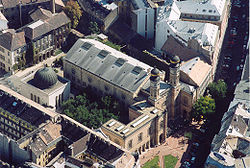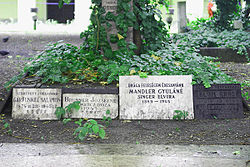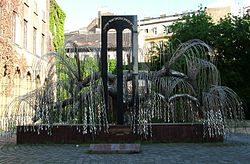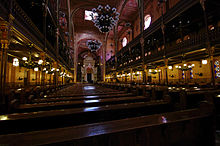- Dohány Street Synagogue
-
Dohány Street Synagogue 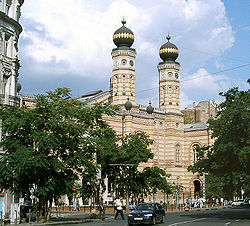
Dohány utcai Zsinagóga
Basic information Location Budapest, Hungary Geographic coordinates 47°29′45″N 19°03′39″E / 47.49583°N 19.06083°ECoordinates: 47°29′45″N 19°03′39″E / 47.49583°N 19.06083°E Affiliation Neolog Judaism Year consecrated 1859 Status Active Synagogue Architectural description Architect(s) Ludwig Förster Architectural style Moorish Revival Direction of façade SWbS Completed 1859 Specifications Capacity 2,964 Length 75 metres (246 ft) Width 27 metres (89 ft) Width (nave) 12 metres (39 ft) Height (max) 43.6 metres (143 ft) The Great Synagogue, also known as Dohány Street Synagogue (Hungarian: Dohány utcai zsinagóga/nagy zsinagóga, Hebrew: בית הכנסת הגדול של בודפשט bet hakneset hagadol šel budapešt) or Tabakgasse Synagogue, is located in Erzsébetváros, the 7th district of Budapest. It is the third largest synagogue in Eurasia[1] and the fifth largest in the world. It seats 3,000 people and is a centre of Neolog Judaism.
The synagogue is 75m long and 27m wide,[2] and was built between 1854 and 1859 in the Moorish Revival style, with the decoration based chiefly on Islamic models from North Africa and medieval Spain (the Alhambra). The synagogue's Viennese architect, Christian Friedrich Ludwig Förster, believed that no distinctively Jewish architecture could be identified, and thus chose "architectural forms that have been used by oriental ethnic groups that are related to the Israelite people, and in particular the Arabs." [3] The interior design is partly by Frigyes Feszl.
Theodore Herzl's house of birth was next to the Dohány street Synagogue. In the place of his house stands the Jewish Museum, which holds the Jewish Religious and Historical Collection, built in 1930 in accordance with the synagogue's architectural style and attached in 1931 to the main building.
Dohány Street itself, a leafy street in the city center, carries strong Holocaust connotations as it constituted the border of the Budapest Ghetto.[4]
Contents
History
Built between 1854-1859 by the Neolog Jewish community of Pest according to the plans of Ludwig Förster, the monumental synagogue has a capacity of 2,964 seats (1,492 for men and 1,472 in the women's galleries) making it the largest in Europe and the second largest working synagogue in the World. The consecration of the synagogue took place on September 6, 1859.
The original synagogue was bombed by the pro-Nazi Arrow Cross Party on 3 February 1939.[5] Used as a base for German Radio and also as a stable during World War II, the building suffered some severe damage from aerial raids during the Nazi Occupation but especially during the Siege of Budapest. During the Communist era the damaged structure became again a prayer house for the much-diminished Jewish community. Its restoration started in 1991 and ended in 1998. The restoration was financed by the state and by private donations.
Exterior
The synagogue was originally built in a residential area. The house in which Theodor Herzl was born once stood on a site that is now part of the synagogue compound. The Dohány Street Synagogue complex consists of the Great Synagogue, the Jewish Museum, the Heroes' Temple, the graveyard and the Holocaust memorial.
Great Synagogue
The building has a length of more than 53 meters while its width has 26.5 meters. The style of the Dohány Street Synagogue is Moorish but its design also features a mixture of Byzantine, Romantic and Gothic elements. Two onion-shaped domes sit on the twin octogonal towers at 43 m height. A rose stained-glass window sits over the main entrance.
Jewish Museum
The Jewish Museum was constructed on the plot where Theodor Herzl's two-story Classicist style house used to stand, adjoining the Dohany synagogue.[6] The Jewish Museum constructed between 1930-1931 holds collection of religious relics of the Pest Hevrah Kaddishah (Jewish Burial Society), ritual objects of Shabbat and the High Holidays and a Holocaust room.
Heroes' Temple
The arcade and the Heroes' Temple, which seats 250 people and is used for religious services on weekdays and during the winter time, was added the Dohány Street Synagogue complex in 1931. The Heroes' Temple designed by Lázlo Vágó and Ferenc Faragó, serves as a memorial to Hungarian Jews who gave their lives during World War I.
Jewish Cemetery
The cemetery is located in the back yard of the Heroes' Temple, enclosed by the Jewish Museum and the Dohany synagogue. According to the Jewish traditions cemeteries can not be on the premises of the house of prayer[citation needed]. This graveyard is the result of tragic historical events during World War II. In 1944, the Dohány Street Synagogue was part of the Jewish Ghetto for the city Jews and served as shelter for a lot of people. Over two thousand of those who died in the ghetto from hunger and cold during the winter 1944-1945 are buried in the courtyard of the synagogue.
Raoul Wallenberg Holocaust Memorial Park
The Raoul Wallenberg Emlékpark (memory park) in the rear courtyard holds the Memorial of the Hungarian Jewish Martyrs — at least 400,000 Hungarian Jews were murdered by the Nazis.[7] Made by Imre Varga, it resembles a weeping willow whose leaves bear inscriptions with the names of victims. There is also a memorial to Wallenberg and other Righteous Among the Nations, among them: Swiss Vice-consul Carl Lutz; Giorgio Perlasca, an Italian man who, with a strategic escamotage, declared himself the Spanish consul, releasing documents of protection and current passports to Jews in Budapest without distinction (he saved five thousand); Mons. Angelo Rotta, an Italian Prelate Bishop and Apostolic Nuncio of the State of Vatican City in Budapest, which issued protective sheets, misrepresentations of baptism (to save them from forced labor) and Vatican passports to Jews, without distinction of any kind present in Budapest (saving fifteen thousand), who saved, with his secretary Mons. Gennaro Verolino tens of thousands of Hungarian Jews during World War II.
Interior
Similarly to basilicas, the building consists of three spacious richly decorated aisles, two balconies and, unusually, an organ. Its ark contains various torah scrolls taken from other synagogues destroyed during the Holocaust[citation needed].
The torah-ark and the internal frescoes made of colored and golden geometric shapes are the works of the famous Hungarian romantic architect Frigyes Feszl. A single-span cast iron supports the 12-m wide nave. The seats on the ground-floor are for men, while the upper gallery, supported by steel ornamented poles, has seats for women.
Franz Liszt and Camille Saint-Saëns played the original 5,000 pipe organ built in 1859.[8] A new mechanical organ with 63 voices and 4 manuals was built in 1996 by the German firm Jehmlich Orgelbau Dresden GmbH.[9]
Renovation
It was only in the 1990s, following the return to democracy in Hungary, that renovations could begin. A three-year program of reconstruction (funded largely by a US$ 5 million donation from Hungarian Jewish immigrant Estée Lauder[10]) was completed in 1996.[11]
Trivia
Dohány means tobacco in Hungarian. Theodor Herzl in his speeches[12] and the Jewish Encyclopedia referred to the Dohány Street Synagogue as the Tabakgasse Synagogue. The Dohány Street Synagogue is also known under the name of the Tabak-Shul, the Yiddish translation of Dohány Synagogue.
The sanctuary building of Central Synagogue in Manhattan, New York City is a near-exact copy of the Dohány Street Synagogue.[13]
Notes
- ^ Kulish, Nicholas (2007-12-30). "Out of Darkness, New Life". The New York Times. http://travel.nytimes.com/2007/12/30/travel/30dayout.html?scp=1&sq=largest+synagogue+in+Europe&st=nyt. Retrieved 2008-03-12.
- ^ Frojimovics, Kinga; Komoróczy, Géza; Pusztai, Viktória and Strbik, Andrea (1999). Jewish Budapest: Memories, Rites, History. Central European University Press. ISBN 9639116378, p. 111.
- ^ Ludwig Förster, Allgemeine Bauzeitung, 1859, pp. 14-16; drawings on pp. 230-235.
- ^ http://www.vendegvaro.hu/Dohany-utcai-zsinagoga-Budapest
- ^ Frank, Tobor (2003). Discussing Hitler: Advisors of U.S. Diplomacy in Central Europe 1934-1941. Central European University Press. ISBN 9639241563, p. 225.
- ^ Herzl, Theodor (January 1898). "An Autobiography". London Jewish Chronicle: 20. http://archive.thejc.com/search/pages.jsp?issue=JANUARY%2014%201898. Retrieved 2008-03-18. "I was born in 1860 in Budapest in a house next to the synagogue where lately the rabbi denounced me from the pulpit in very sharp terms (...)"
- ^ Rosen, Ilana (2004). Hungarian Jewish Women Survivors Remember the Holocaust. University Press of America, ISBN 0761827048, p.3.
- ^ Perlman, Robert (1991). Bridging Three Worlds: Hungarian-Jewish Americans, 1848-1914. University of Massachusetts Press. ISBN 0870234684, p. 72.
- ^ Jehmlich Orgelbau Dresden GmbH. "Organ of the Budapest Synagogue". http://www.jehmlich-orgelbau.de/englisch/organs/organ_1121.htm. Retrieved 3-17 2008.
- ^ Mars, Leonard (2003). Jewish Identity in Contemporary Hungary. Acta Ethnographica Hungarica, 48(1-2), 35-48.
- ^ Troen, Selwyn (1998). Jewish Centers and Peripheries: Europe Between America and Israel Fifty Years After World War II. Transaction Publishers, ISBN 1560003731, p. 135.
- ^ Herzl, Theodor (1960). "Herzl Speaks: His Mind on Issues, Events and Men". Herzl Institute Pamphlet (New Yotk: The Herzl Press) 16. http://www.hagshama.org.il/en/resources/view.asp?id=1634. "I went...to the synagogue [in Paris] and found the services once again solemn and moving. Much reminded me of my youth and the Tabakgasse synagogue in Pest."
- ^ Jewish Budapest: monuments, rites, history
See also
- Ujpest Synagogue
- Synagogues built in the Moorish Revival style:
References
- Kalmar, Ivan Davidson (2001). "Moorish Style: Orientalism, the Jews, and Synagogue Architecture" (PDF). Jewish Social Studies History Culture and Society 7 (3): 68. doi:10.2979/JSS.2001.7.3.68. http://www.library.utoronto.ca/moorish/publications/moorish.style.pdf. Retrieved 2008-03-19.
Gallery
External links
- Tourism Office of Budapest info on the Synagogue
- Official Home page of the Synagogue in Hungarian (English, Hungarian)
- This article incorporates text from the 1901–1906 Jewish Encyclopedia article "Budapest" by Gotthard Deutsch, Alexander Büchler, a publication now in the public domain.
- Official interactive 3D virtual tour using 360° panoramic images Photo by Csaba Legány
- 360° interactive high resolution panoramic photo of the interiors of the Synagogue Photo by Hans von Weissenfluh
- Video Virtual tour [1]
- Accommodation with concierge services in the Jewish Quarter
- 360° high resolution panoramic photos of the interiors of the Synagogue Photo by Sandor Veress
Categories:- Synagogues in Budapest
- Neolog Judaism synagogues
- Moorish Revival synagogues
- Erzsébetváros
- Religious buildings completed in 1859
- 19th-century synagogues
- Landmarks in Hungary
Wikimedia Foundation. 2010.

